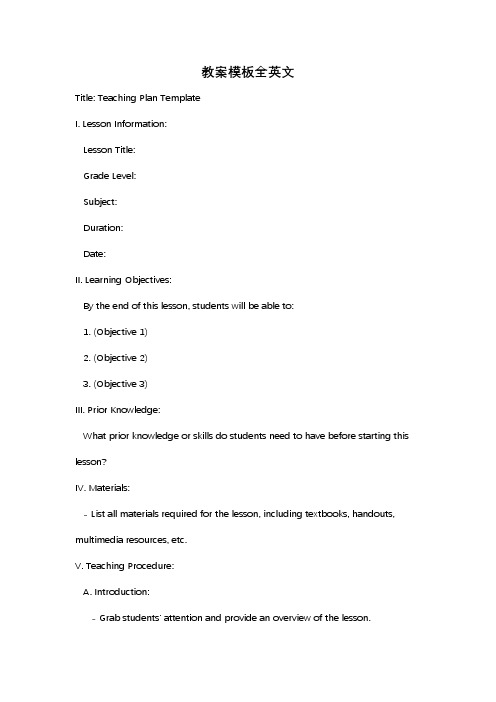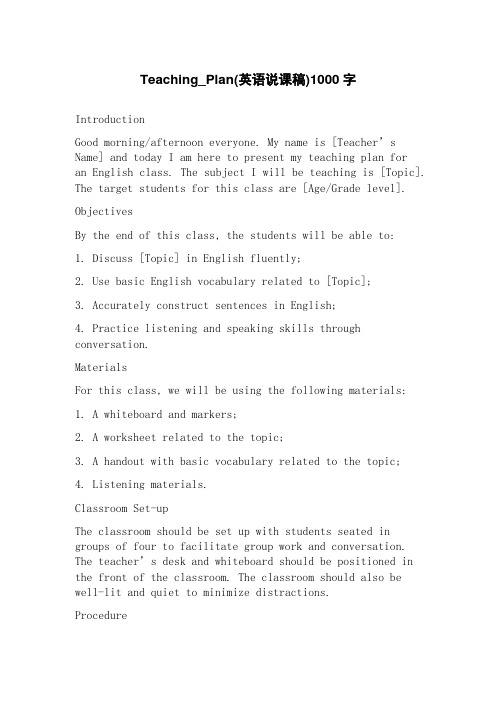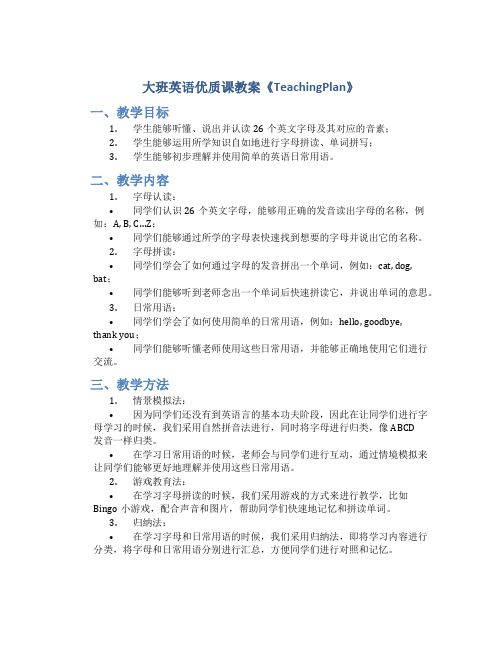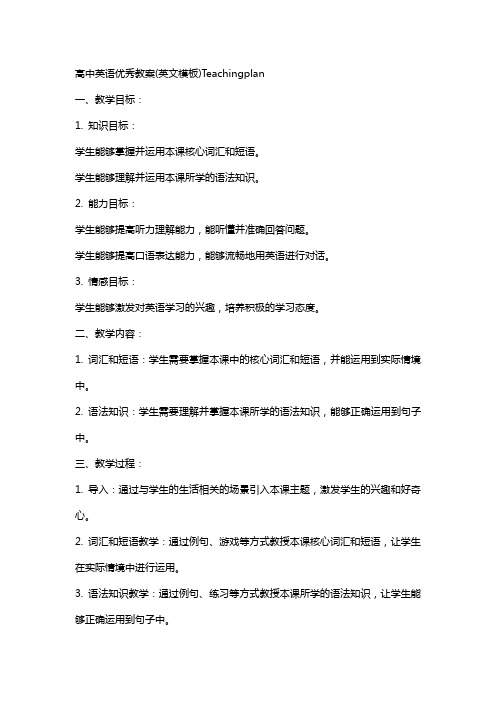Teaching Plan(模板)
教案模板全英文

教案模板全英文Title: Teaching Plan TemplateI. Lesson Information:Lesson Title:Grade Level:Subject:Duration:Date:II. Learning Objectives:By the end of this lesson, students will be able to:1. (Objective 1)2. (Objective 2)3. (Objective 3)III. Prior Knowledge:What prior knowledge or skills do students need to have before starting this lesson?IV. Materials:- List all materials required for the lesson, including textbooks, handouts, multimedia resources, etc.V. Teaching Procedure:A. Introduction:- Grab students' attention and provide an overview of the lesson.- Connect the lesson to prior knowledge or real-life examples.B. Instructional Input:- Present new information or concepts using various teaching methods (lecture, demonstration, multimedia, etc.).- Break down complex ideas into smaller, more manageable parts.- Use visuals, examples, and analogies to enhance understanding.C. Guided Practice:- Engage students in activities or exercises that reinforce the newly learned concepts.- Provide clear instructions and model the desired behavior or thinking process.- Monitor students' progress and provide timely feedback.D. Independent Practice:- Assign individual or group activities to allow students to apply their learning independently.- Provide necessary resources and clarify expectations.- Encourage critical thinking and problem-solving skills.E. Closure:- Summarize the key points of the lesson.- Allow students to ask questions or clarify any confusion.- Provide a preview of the next lesson or connect the current lesson to future learning.VI. Assessment:- Explain how student learning will be assessed (formative and/or summative assessments).- Describe the assessment methods and criteria used.- Indicate when and how feedback will be provided to students.VII. Differentiation:- Describe any modifications or accommodations for students with diverse learning needs.- Include strategies to support English language learners, gifted students, or students with special needs.VIII. Extension Activities:- Optional activities or resources for students who finish early or want to explore the topic further.IX. Reflection:- Reflect on the effectiveness of the lesson and make notes for future improvements.- Consider student engagement, understanding, and overall lesson objectives. Please note that this teaching plan template can be adapted and customized based on the specific requirements and educational stage.。
Teaching_Plan(英语说课稿)

Teaching_Plan(英语说课稿)1000字IntroductionGood morning/afternoon everyone. My name is [Teacher’s Name] and today I am here to present my teaching plan foran English class. The subject I will be teaching is [Topic]. The target students for this class are [Age/Grade level].ObjectivesBy the end of this class, the students will be able to:1. Discuss [Topic] in English fluently;2. Use basic English vocabulary related to [Topic];3. Accurately construct sentences in English;4. Practice listening and speaking skills through conversation.MaterialsFor this class, we will be using the following materials:1. A whiteboard and markers;2. A worksheet related to the topic;3. A handout with basic vocabulary related to the topic;4. Listening materials.Classroom Set-upThe classroom should be set up with students seated in groups of four to facilitate group work and conversation. The teacher’s desk and whiteboard should be positioned in the front of the classroom. The classroom should also bewell-lit and quiet to minimize distractions.Procedure1. Warm-up Activity (10 minutes)The teacher will start the class with a warm-up activity to get the student’s minds focused and engaged. This activity will include asking the students to introduce themselves and talk about their hobby in English. Through this activity, students can introduce themselves to their peers, and start practicing their speaking skills. This activity will also help in establishing rapport within the class.2. Introduction of Vocabulary (20 minutes)The teacher will then move on to introducing basic vocabulary related to the topic of [Topic]. The vocabulary will be presented through a handout and the teacher will ask the students to match the words with their corresponding meanings. This activity will help familiarize the students with the terminology related to [Topic].3. Individual Work (20 minutes)After the introduction of vocabulary, students will be given a worksheet related to [Topic]. Students will be asked to answer questions related to [Topic] based on the information they have learned from the handout. Thisactivity will help students practice their reading and comprehension skills while also reinforcing their understanding of the vocabulary.4. Group Work (25 minutes)In this activity, students will be divided into groups of four. Each group will be given a set of pictures related to [Topic]. Students will then be asked to describe what they see in the picture in English. Through this activity, the students will be able to practice their speaking and listening skills while also practicing constructing sentences in English.5. Conclusion and Feedback (10 minutes)To end the lesson, the teacher will summarize the keypoints of the lesson and ask for feedback from the students regarding the class. The teacher will also address any questions or concerns from the students. This activity will help ensure the students have understood the lesson andgive them the opportunity to provide feedback about the class.ConclusionIn conclusion, this teaching plan is designed to help students practice their English language skills while also learning about [Topic]. Through this plan, students will engage in activities that develop their listening, speaking, reading and writing skills. It is hoped that by the end of the class, the students will leave with a deeper understanding of [Topic] and improved English language proficiency. Thank you for listening.。
Teaching Plan 教案模板

Teaching PlanClass: Junior Middle School, Class 8, Grade 7Material: Go for it! , Unit 5, Section AObjectives: Training four skills in the following function, using the following structuresFunction: Expressing ideas when doingStructures: What is he/she doing? He/She is…Teaching aids: A slide projector, tape player, audiotape. Blackboard DesignProcedurePossible Problems Possible Solutions·Too many new words, this may ·Ts present new vocabulary easilytake too long to get started ·Ts help Ss learn them by heart ·Ss might not feel confident enough to ·Ts go round class and encourage speak in the group activities Ss to get started and keep going教学反思Unit 5 I am watching TV.(Section A 1a--2c)本节课是Go for it (下) Unit 5 I am watching TV.的第一课时。
主要围绕“What are you doing?”这一主题展开各种教学活动,并以这一主题引出现在进行时各种人称的一般疑问句及其回答这一语言功能。
大班英语优质课教案《TeachingPlan》

大班英语优质课教案《TeachingPlan》一、教学目标1.学生能够听懂、说出并认读26个英文字母及其对应的音素;2.学生能够运用所学知识自如地进行字母拼读、单词拼写;3.学生能够初步理解并使用简单的英语日常用语。
二、教学内容1.字母认读:•同学们认识26个英文字母,能够用正确的发音读出字母的名称,例如:A, B, C…Z;•同学们能够通过所学的字母表快速找到想要的字母并说出它的名称。
2.字母拼读:•同学们学会了如何通过字母的发音拼出一个单词,例如:cat, dog, bat;•同学们能够听到老师念出一个单词后快速拼读它,并说出单词的意思。
3.日常用语:•同学们学会了如何使用简单的日常用语,例如:hello, goodbye,thank you;•同学们能够听懂老师使用这些日常用语,并能够正确地使用它们进行交流。
三、教学方法1.情景模拟法:•因为同学们还没有到英语言的基本功夫阶段,因此在让同学们进行字母学习的时候,我们采用自然拼音法进行,同时将字母进行归类,像ABCD发音一样归类。
•在学习日常用语的时候,老师会与同学们进行互动,通过情境模拟来让同学们能够更好地理解并使用这些日常用语。
2.游戏教育法:•在学习字母拼读的时候,我们采用游戏的方式来进行教学,比如Bingo小游戏,配合声音和图片,帮助同学们快速地记忆和拼读单词。
3.归纳法:•在学习字母和日常用语的时候,我们采用归纳法,即将学习内容进行分类,将字母和日常用语分别进行汇总,方便同学们进行对照和记忆。
四、教学步骤1. 字母认读1.听老师读出26个英文字母的名称,同学们跟读;2.分组比赛,根据老师所说的字母名称,第一个跟读出来的小组获胜;3.学生自由读出由老师即兴出现的随意字母。
2. 字母拼读1.老师播放音频,让学生们听声音,说出音频中的每个单词中的字母;2.BINGO小游戏,根据音频快速拼读单词并标记;3.学生自己编写单词进行拼读及说出意思。
【完整版】-Teaching Plan

Teaching PlanTeaching contents: Module 6 Reading and vocabularyThe Monster of Lake TianchiTeaching Objectives:1.Learn to use different reading skills to understand the monster of the passage.2.To be able to make a brief introduction about the monster of lake Tianchi.Teaching important points: Using different reading skills to understand the passage.Teaching difficult points: How to use some simple words describe a monster.Teaching aids: ppt, blackboard, textbook,chalkTeaching procedure:Step 1: GreetingT: Gooding morning class.S:.Step 2: Lead inT: This class we will learn module 6 reading part—the monster of lake Tianchi. Before the class I have a question“when we talk about monsters what kind of pictures will you think about?”停顿3秒。
(show the picture)Maybe like this, it is ugly. Maybe like this, it is frightening. Maybe like this , it is mysterious. However, look at this picture, do you think there is a monster in the lake?S:Yes/NOT:Someone said yes, someone said no, the answer is on the book, please open your book on page52, read the passage and get more information.Step 3 PresentationFast reading;T;Is there a monster in the lake?S:YesT:BingoQ; where does the passage come from?Tourist guide a newspaper a dictionary a scientific journalQ:What is the topic sentences in the passage?Paragraph 1 the first sentenceCareful reading:1.Match the key words with the paragraphs.Para1 people’s opinionPara2 sighting 1Para3 sighting 3Para4 sighting 2Para5 the information about lake Tianchi2.Para1-3 Find the monster’s shape and action in each sighting.3.Para 4What’s people’s opinion about the monster?What scientisits’ opinion about the monster?4.Para 5 the information about lake tianchiHeight:Area:Depth:Step 4 SummarySuppose you are a guide and you want to introduce the lake to the forerners, please fill in the blank.Step 5 Post reading activitiesStudent A: ReporterStudent B: TouristPlease make a report about the event I will give you an example like this.Reporter: Where are you when the monster appear?Tourist: I was in the…Reporter: What did you saw?Tourist: I saw…….Step 6: HomeworkWrite a short passage to describe a monster you imagined or you have seen.。
高中英语教案(英文模板)Teachingplan

高中英语优秀教案(英文模板)Teachingplan一、教学目标:1. 知识目标:学生能够掌握并运用本课核心词汇和短语。
学生能够理解并运用本课所学的语法知识。
2. 能力目标:学生能够提高听力理解能力,能听懂并准确回答问题。
学生能够提高口语表达能力,能够流畅地用英语进行对话。
3. 情感目标:学生能够激发对英语学习的兴趣,培养积极的学习态度。
二、教学内容:1. 词汇和短语:学生需要掌握本课中的核心词汇和短语,并能运用到实际情境中。
2. 语法知识:学生需要理解并掌握本课所学的语法知识,能够正确运用到句子中。
三、教学过程:1. 导入:通过与学生的生活相关的场景引入本课主题,激发学生的兴趣和好奇心。
2. 词汇和短语教学:通过例句、游戏等方式教授本课核心词汇和短语,让学生在实际情境中进行运用。
3. 语法知识教学:通过例句、练习等方式教授本课所学的语法知识,让学生能够正确运用到句子中。
四、作业布置:1. 词汇和短语练习:让学生完成相关的词汇和短语练习题,巩固所学知识。
2. 口语作业:让学生与同学进行对话练习,提高口语表达能力。
五、教学评价:1. 课堂参与度:观察学生在课堂上的积极参与程度和表现。
2. 作业完成情况:检查学生完成作业的情况,巩固所学知识。
3. 口语表达能力的提高:通过对话练习,评估学生的口语表达能力是否有提高。
六、教学策略:1. 任务型教学法:通过设计各种真实的任务,让学生在完成任务的过程中运用所学知识,提高语言运用能力。
2. 交际式教学法:鼓励学生积极参与课堂对话,培养学生的交际能力和团队合作精神。
3. 情境教学法:创设各种真实的学习情境,让学生在实际情境中感知和运用语言。
七、教学资源:1. 教材:使用符合课程标准的高中英语教材,为学生提供丰富的学习内容。
2. 多媒体设备:利用多媒体课件、视频等资源,丰富教学手段,提高学生的学习兴趣。
3. 网络资源:利用网络资源,为学生提供更多的学习资料和实践平台。
Teaching Plan 教学计划【范本模板】

e。g. a superior cloth,team, standard上等布、强队、高水平
★ deceptively adv。
in a deceptive or deceiving manner;so as to deceive欺骗地,采取欺骗方式地
(a) to do sth wrong or illegal做出(错或非法的事),犯(罪或错等)
e.g。commit murder犯谋杀罪
Most crimes are committed by young men.多数Байду номын сангаас行都是年轻人犯下的.
(b)[often passive] to promise sincerely that you will definitely do sth,keep to an agreement or arrangement,etc.承诺,保证(做某事、遵守协议或遵从安排等)
e。g. She has a good command of five foreign languages。她熟练掌握五门外语。
★ wholesaler n。
a person whose business isbuying large quantities of goods and selling them in smaller amounts,for example to shops批发商
e.g。The rabbits are bred for their long coats.饲养兔子是为了获取他们的长毛。
★harvest v。&n。
v. gather (a crop);reap收割(庄稼);收获
teaching plan 详细英语教学计划模板

Lesson Plan of Integrated SkillsBackground Information:Students:Junior 3(42 students)Lesson Duration:40minsTeaching Objectives:By the end of the lesson, students should be able to:1. distinguish commands and requests.2 know how to use commands and requests.3. use polite expression in their conversation.4. express themselves both in direct speech and indirect speech.Teaching Contents:1. Expressions of command and request.2. Direct and indirect speech.Teaching aids: blackboard, chalk, computer, power-pointType of the lesson: Integrated SkillsTeaching procedures:Step 1.Warm-up(3mins) Listen and Answer1.The teacher says 6 sentences and asks students to classify them into commands and requests.(The sentences are: a. Do that now! b. How do you spell that please? c. Go and buy some more petrol! d. Would you please repeat the sentence? e. Can I sit here and wait for the doctor? f. Correct your spelling mistakes.)Step 2: Individual work (8mins) Read and WriteLet students think about the difference between the request and command. Then read the replies and decide whether they are in answer to a request or a command. Write the sentence down.★A: _______________________________________B: I’ll go and collect some wood right now, master.★ A: _______________________________________B: O f course I’ll be happy to collect your shopping for you.★A:__________________________________________B: Yes. I’ll shut the door at once, Mr. Zhang.★A:_________________________________________B: No, I won’t get your coat if you talk to me like that.Step 3. (10mins) Reading and Speaking1.Students read the following dialogues and pay attention to the commands and requests.Situation 1A: Excuse me. Who would do me a favor to close the door?B: Speak louder?A: Will you please close the door?B: OK. I will.A: Thank you very much.B: My pleasure.Situation 2A: Excuse me. It’s time for me to get off. Would you please make way for me?B: Of course. I’ll be happy to make way for you. Go ahead.A: Thank you.B: You’re welcome. Oh, my God, I need to lose my weight.2. Work in pairsMake dialogues using the commands/requests. Students are encouraged to imagine interesting dialogues.Step 4: (12mins)1 Pair work Students read carefully and discuss in pairs to find out the rules about direct and indirect speech.“Write a letter to your parents.”The teacher told me to write a letter ….“Don’t play games in the classroom.”The teacher ordered me not to play games“Can you pass on the book to Tom?”The teacher ask ed me to pass on …“Will you please not smoke here?”The teacher asked me not to smoke there.After asks students what they have found out about the rules, the teacher concludes:If we change commands, we may use the patterns:sb. told/ordered sb. else(not)to do sth. ;if we change requests, we can use “sb. asked sb. else(not)to do sth. ”Step 5(5mins)Choose two students act as two robots. Other students give either requests or commands.One robot repeats the requests and the commands to the other robot using indirect speech, so the other robot does what asked to do.Step 6.(1mins)Summarize the contents of this lesson:mands and requests2.direct and indirect speechStep7.(1min)Assign homework:1.Write a dialogue using commands and requests.2.Change your own dialogue into indirect speech.Optional activity:1.Making commands and requests using indirect speechIn groups of four, think of at least three commands your teachers and parents usually give. Students follow these steps.1)Choose one who is to give the first command.2)Ask another person in your group to tell somebody what you said.3)The third person will change the request or command from direct into indirect speech.4)Change role so that each person gets the chance to give commands and turn them intoindirect speech.2 Pair work:Ask one student to give a command and then the other change into a request.。
- 1、下载文档前请自行甄别文档内容的完整性,平台不提供额外的编辑、内容补充、找答案等附加服务。
- 2、"仅部分预览"的文档,不可在线预览部分如存在完整性等问题,可反馈申请退款(可完整预览的文档不适用该条件!)。
- 3、如文档侵犯您的权益,请联系客服反馈,我们会尽快为您处理(人工客服工作时间:9:00-18:30)。
Teaching Plan
Teaching Content:
Go for it, (students’ book of grade 9)
Unit 1 How do you study for a test? (Section B, 3a, 3b, 3c.)
Teaching Time: One class hour (40 minutes)
Teaching Aims:
1. Learn and master new words, phrases and sentence patterns.
2. Enable the students to talk in English about how to study English very well.
3. Develop the students reading and writing ability.
Important Points:
1. Master some phrases and the objective clause.
2. Improve the students’ reading and writing ability on English learning skills.
3. Learn to co-operate in the study with classmate
Teaching Difficult Points:
1. Phrases and Sentence Patterns:
first of all, later on, laugh at, take notes
Sb. realize that – clause
2.Improve the students’ reading skills---skimming and scanning, locating the specific
information.
Teaching Methods:
1. Task-based language teaching method.
2. Question-and-answer activities to help the students to go through the whole passage.
3. Individual, pair and group work to make every student work in class.
Teaching Aids:
The blackboard
Teaching Procedures:
Step 1 Greeting(1 min)
Teacher uses different greeting expression to say “hello” with the students Step 2 Revision and lead-in(3 min)
The teacher review the language points by asking the following questions:
1.Can you speak English?
2.How long have learned English?
3.Are you enjoying learning English?
4.Do you have good ways to study English well?
Step 3 Presentation for reading(4 min)
Students are asked to discuss with partner in 2 minutes and answer the question: Would you like to learn English well?
Step 4 While-reading (25min)
1. Fast reading(5 min)
The students are given 2 minutes to read passage quickly. And then answer a question: How does she learn English well?
The right answer will be repeated and written on the blackboard.
2. Careful reading(10 min)
After the teacher explain the main phrases “first of all, later on, laugh at, take notes”,
and sentence patterns “ Sb. realize that – clause”, the students are given 4 minutes to
read passage carefully again and do the exercises in pairs 3a, 3b,.
The answer will be shared by the students in the group. And one representative will
share their group’s answer with the whole class.
3. Practice(10 min)
1) The teacher summarizes the good ways to learn English mentioned in the text..
2) Divide students to groups to discuss how to become a better language learner.
Then write a complete letter with about 50 words.
Step 5 Post-reading(6 min)
Make a competition: Invite the leader to read the complete letter.
Step 6 Homework(1min)
e the vocabulary learned in the class to write a short report on your own learning experience.
2.Do a research on the good or helpful lessons on English learning.
The Blackboard Design:
Reflection:(It will be written just after class)。
